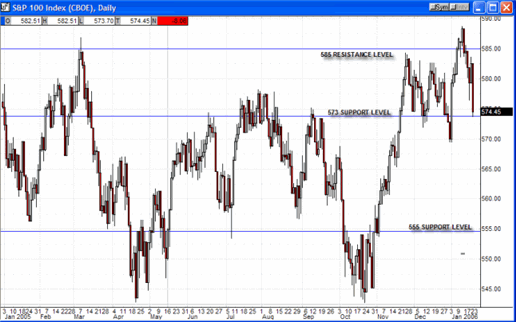The strategy that options traders should use in this market
As evidenced by the chart below, financial markets have been trading in a fairly narrow trading range for the past two months between the 573 and 585 level on the S&P 100 index. As I am writing this article, the S&P 100 index is approaching the 573 support level. A clear break of the index below 573 will set in motion a nasty decline phase.
From a longer-term perspective, the current breakdown in the stock market is not surprising. Here are the facts. The S&P 100 index closed at the 575.29 level on December 31, 2004. The index is trading at the 575.11 level presently, or unchanged for the past year.

In looking at the chart below, we see that the S&P 100 index traded in a very narrow range for most of the last year between the 555 and 577 levels.

In essence, nothing has happened in financial markets for the past year. The total yearly range for the S&P 100 in 2005 from its lowest to its highest price was 8%, and the index was locked in a very narrow trading range of about 4% for most of the year.
While very little has happened in financial markets in over a year, this does not mean that there were not excellent opportunities to profit with options. Options have the unique characteristic of being able to earn profits when the security underlying the options sits still by using the time depreciation characteristic of the options. This means that by selling options, one can profit when financial market conditions are static as they have been in the past year.
Using the time depreciation characteristic of options, our recommendations have accrued over 126% in profits (excluding brokerage fees) since July 2004, without a single losing trade recommendation. We have achieved these results while financial markets have been essentially unchanged.
Bottom Line:
Looking to the coming year, it is likely that financial markets will remain in the trading range set forth in the long-term chart above. This means that traders can look to execute long positions when the S&P 100 index declines to between the 543-555 levels and seek to take profits, or enter short positions when the index rises to between the 577-585 levels. Option traders should sell time premium to benefit from static financial markets.
Sincerely, Charles Sachs Chief Options Strategist
Charles Sachs has utilized S&P 100 for the past 14 years, both as a trader and an advisor. He uses 24 proprietary indicators in order to structure options strategies which can generate gains whether the market moves up, down or sideways.
